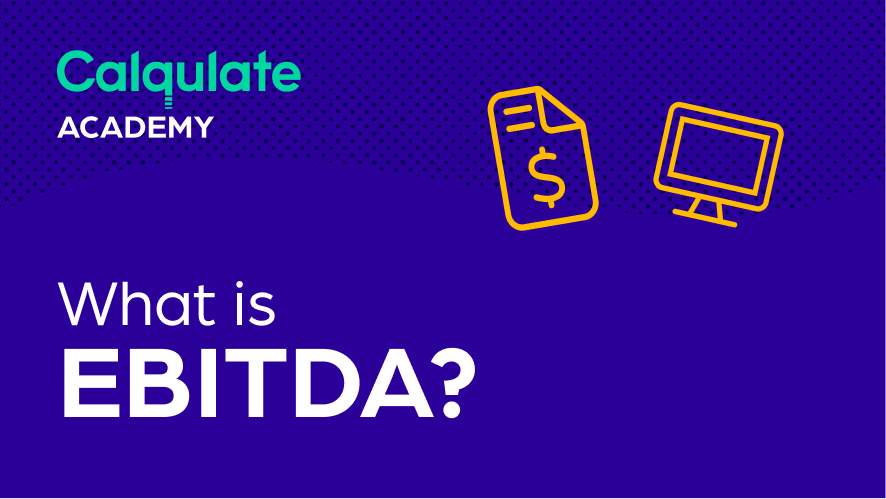Before we dive into formulas and calculations, let’s take a look at what goes into a SaaS Profit & Loss (P&L) statement. The main elements to pay attention to are:
- Revenue
- Cost of Sales (COS)
- Gross margin
- Operating Expenses
- EBITDA
- Depreciation & Amortization
- Interest Expense and Income
- Taxes
- Net profit
What is EBITDA?
EBITDA stands for Earnings Before Interest, Tax, Depreciation, and Amortization. It’s a metric that measures a company’s overall financial performance. Essentially, it’s a valuation tool investors use to gauge your company’s profitability before further investment.
You may wonder: Didn’t we just talk about metrics that measure a company’s financial performance?
You are right. We did. When it comes to the performance of your SaaS business, there are various ways to measure your company’s profitability:
- Gross margin: Your overall gross margin gives you an idea of your production costs in relation to your revenue. It helps you figure out how to grow your revenue faster than your production cost and how to build a scalable business.
- Net profit: Your net profit gives you an idea of the money you have left after you’ve paid all expenses, loan interests, and amortized your assets. Simply because growing revenue doesn’t necessarily translate into more profit.
- EBITDA: Your EBITDA gives you an idea of your ability to generate cashflows and your company’s operating performance. It takes into account operational expenses ONLY that are necessary to run your business.
Many SaaS companies struggle to understand EBITDA. It’s without a doubt a complex topic. But it does get easier once you understand the elements in a P&L statement. We’ll start here:
- Depreciation and Amortization
Depreciation and Amortization are methods used to spread your assets’ costs over a specific period of time, for example, over multiple years.
Depreciation is used to pro-rate tangible assets such as equipment, computers, vehicles, etc. For example, suppose you purchase a company car for $60,000 with an estimated lifespan of 10 years. In that case, we can assume that the company’s annual depreciation expense for the vehicle is $6,000 ($60,000/10 years) instead of booking it 100% as an expense in the first year.
Amortization, on the other hand, is used to pro-rate intangible assets such as trademarks and copyrights. For example, if you spent $40,000 obtaining a trademark that will expire in 5 years, we can assume that the company’s annual amortization expense is $8,000 ($40,000/5 years).
To sum it up, this section in your P&L statement is all about the assets – both tangible and intangible.
- Interest Expense and Income
Interest expense is the cost incurred for any borrowed funds – bonds, loans, convertible debts, or credit lines. In other words, your company’s debts.
It’s common for companies to fund operations using debts. Debts are unavoidable unless you have a huge enough (and endless pool of) capital to begin with. However, your interest expense has an impact on your company’s profitability. That said, the larger the debt, the more significant the impact.
For example, you find yourself having a hard time serving your debt during an economic downturn. What happens then? Your investors will then look at your interest coverage ratio, also known as Earnings Before Interest or Taxes (EBIT), to determine your ability to pay interest with your operating income. The higher the ratio, the better.
Let’s say you have a debt of $200,000 with an interest rate of 10%. That means you have an interest expense of $20,000. Assuming you have an EBIT of $240,000, your interest coverage ratio is 12 ($240,000/$20,000), which means that you can comfortably meet the obligations of paying interest.
But if you only have an EBIT of $40,000, then your interest coverage ratio is 2 ($40,000/$20,000), which means that you may have a hard time staying afloat. A general rule of thumb is, an interest coverage ratio of less than 3 is considered a red flag.
- Taxes
This section is all about the expense caused by tax rates. It includes payable tax liabilities such as sales and income tax – both long-term and short-term.
That’s it! These are the elements you need to understand to obtain your EBITDA.
How to calculate my EBITDA?
The formula for calculating your EBITDA is pretty straightforward:
Net profit + Interest + Taxes + Depreciation + Amortization = EBITDA
Let’s take a look at the following example. Assuming company A has the following variables:
- Revenue (A) = $2,000,000
- Cost of Sales (B) = $450,000
- Operating Expenses = $200,000
- Interest Expense (C) = $20,000
- Depreciation and Amortization (D) = $30,000
- Tax rate (E) = 24%
Here are three key variables we need to know before calculating their EBITDA.
|
Income before taxes (F) |
Taxes (G) |
Net profit |
|
|
Formula |
A-B-C-D |
F x E |
F - G |
|
Total |
$1,500,000 |
$360,000 |
$1,140,000 |
Once again, the formula to obtain your EBITDA is:
Net profit + Interest + Taxes + Depreciation + Amortization = EBITDA
Therefore, company A’s EBITDA is:
$1,140,000 + $20,000 + $360,000 + $30,000 = $1,550,000
What can it tell you?
As with any given metric, looking at your EBITDA in isolation is not going to provide a complete picture of your company’s performance. It will provide your investors and financing partners the answers they are looking for when deciding which company to fund. Here’s why:
EBITDA is used as a tool to evaluate two relatively similar businesses within the same industry. Remember, all companies are not created equal. Using EBITDA as an evaluation metric allows for a more “apples-to-apples” comparison because it eliminates other extra factors such as capital structures and assets’ costs.
Let’s continue to build on the above example. Assuming companies A and B have the following variables:
|
Company A |
Company B |
|
|
Net profit |
$1,140,000 |
$1,140,000 |
|
Interest Expense |
$20,000 |
$80,000 |
|
Depreciation and Amortization |
$200,000 |
$20,000 |
|
Taxes |
$360,000 |
$360,000 |
|
EBITDA |
$1,720,000 |
$1,600,000 |
There are a few possible conclusions for this example:
- Company A’s EBITDA is higher than Company B despite having the same net profit because Company A has more assets and higher depreciation and amortizations.
- If both companies have the same amount of debt, this may indicate that Company A probably has a better credit rating and pays a lower interest rate. Therefore, it has less risk and a higher value.
- Most likely, Company B uses more debt to finance its operations and has higher interest expenses. It is less profitable in the long run.
Based on the above comparison, it seems that Company A is a better investment as compared to Company B. However, these are just assumptions. How would an investor know for sure?
It’s all in the EBITDA margin
While your EBITDA provides your company’s operating performance, your EBITDA margin indicates growth potential.
Investors use the EBITDA margin to understand how much operating cash is generated in relation to the total revenue earned and use it as a benchmark to decide the most financially efficient investment.
The formula for calculating your EBITDA margin is:
EBITDA / Total revenue = EBITDA margin
Assuming the above companies have the same total revenue of $10,000,000, this is how their EBITDA margin looks like:
|
Company A |
Company B |
|
|
Calculation |
$1,720,000 / $10,000,000 |
$1,600,000 / $10,000,000 |
|
EBITDA margin |
17.2% |
16% |
Company A demonstrates a higher growth potential because it has a higher margin than Company B. Therefore, an investor weighing up both businesses will probably favor Company A over B.
Up until this point, Company A has been the more favorable option for investors. But, what happens if we assume Company B has a lower total revenue?
An immediate assumption would probably be that Company A would still be a more favorable option because it has a higher EBITDA and total revenue. But is that true? Let’s take a look:
Assuming Company B now has a total revenue of $7,000,000 instead, this is how their EBITDA margin looks like:
|
Company A |
Company B |
|
|
Calculation |
$1,720,000 / $10,000,000 |
$1,600,000 / $7,000,000 |
|
EBITDA margin |
17.2% |
22.9% |
This means that while Company A demonstrates higher EBITDA, it actually has a smaller margin than Company B (17.2% vs. 22.9%) due to higher expenses and a smaller profit margin. In this case, an investor weighing up both businesses will most likely see more potential in Company B than A.
Wait, but why?
The reason is that your EBITDA margin shows investors how much operating cash is generated in relation to all revenue earned. The higher the margin, the better.
Key takeaway:
EBITDA doesn’t account for the ways you finance your company’s operations. But you can determine the underlying profitability of your company by looking at it. That said, your EBITDA will have an impact on the valuation of your company.
It is the most commonly used metric to evaluate a company’s ability to create cashflows from its operations. Investors often use EBITDA as a metric to determine the price they’re willing to invest in a company.
Happy Calqulating!
Go deeper: EBITDA multiples and valuation

